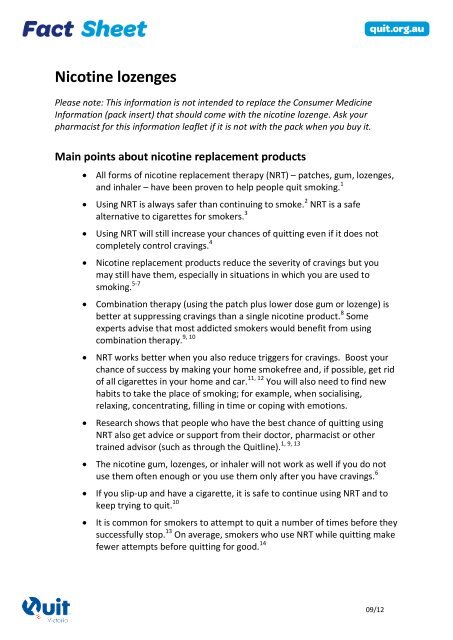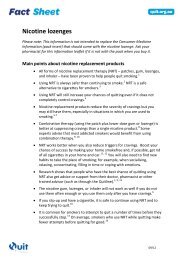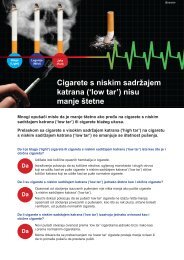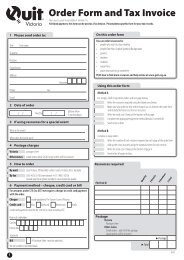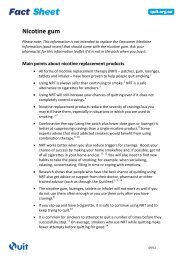Nicotine lozenges - Quit Victoria
Nicotine lozenges - Quit Victoria
Nicotine lozenges - Quit Victoria
You also want an ePaper? Increase the reach of your titles
YUMPU automatically turns print PDFs into web optimized ePapers that Google loves.
<strong>Nicotine</strong> <strong>lozenges</strong><br />
Please note: This information is not intended to replace the Consumer Medicine<br />
Information (pack insert) that should come with the nicotine lozenge. Ask your<br />
pharmacist for this information leaflet if it is not with the pack when you buy it.<br />
Main points about nicotine replacement products<br />
• All forms of nicotine replacement therapy (NRT) – patches, gum, <strong>lozenges</strong>,<br />
and inhaler – have been proven to help people quit smoking. 1<br />
• Using NRT is always safer than continuing to smoke. 2 NRT is a safe<br />
alternative to cigarettes for smokers. 3<br />
• Using NRT will still increase your chances of quitting even if it does not<br />
completely control cravings. 4<br />
• <strong>Nicotine</strong> replacement products reduce the severity of cravings but you<br />
may still have them, especially in situations in which you are used to<br />
smoking. 5-7<br />
• Combination therapy (using the patch plus lower dose gum or lozenge) is<br />
better at suppressing cravings than a single nicotine product. 8 Some<br />
experts advise that most addicted smokers would benefit from using<br />
9, 10<br />
combination therapy.<br />
• NRT works better when you also reduce triggers for cravings. Boost your<br />
chance of success by making your home smokefree and, if possible, get rid<br />
of all cigarettes in your home and car. 11, 12 You will also need to find new<br />
habits to take the place of smoking; for example, when socialising,<br />
relaxing, concentrating, filling in time or coping with emotions.<br />
• Research shows that people who have the best chance of quitting using<br />
NRT also get advice or support from their doctor, pharmacist or other<br />
1, 9, 13<br />
trained advisor (such as through the <strong>Quit</strong>line).<br />
• The nicotine gum, <strong>lozenges</strong>, or inhaler will not work as well if you do not<br />
use them often enough or you use them only after you have cravings. 6<br />
• If you slip-up and have a cigarette, it is safe to continue using NRT and to<br />
keep trying to quit. 10<br />
• It is common for smokers to attempt to quit a number of times before they<br />
successfully stop. 13 On average, smokers who use NRT while quitting make<br />
fewer attempts before quitting for good. 14<br />
09/12
Is the nicotine lozenge suitable for me?<br />
2<br />
The nicotine lozenge works best for addicted smokers who want to quit. 1, 9, 13 Your<br />
doctor or pharmacist can advise you whether the nicotine lozenge is suitable for you.<br />
Signs of addiction include:<br />
9, 15<br />
• You smoke your first cigarette within 30 minutes of waking up.<br />
• You smoke more than 10 cigarettes per day. 9, 15 (There is no difference<br />
between smoking stronger or weaker tasting cigarettes. 16 )<br />
• You suffer from withdrawal symptoms within 24 hours of stopping smoking,<br />
such as cravings, irritability, anxiety, depression, restlessness, hunger, poor<br />
9, 17<br />
concentration or sleep disturbances.<br />
If you are age 12 years and over, you may use the nicotine lozenge. However if you<br />
9, 18, 19<br />
are under 18 years you should speak to your doctor before using the lozenge.<br />
It is strongly recommended that people in this age group discuss quitting smoking<br />
13, 19, 20<br />
with a trained health advisor to benefit from using the nicotine lozenge.<br />
It is not known whether smokers of 10 or less cigarettes per day would benefit from<br />
using the nicotine lozenge, but counselling and use of self-help materials is<br />
1, 9, 13<br />
encouraged.<br />
How does the nicotine lozenge work?<br />
Addiction to nicotine in tobacco is the main reason why people continue to smoke.<br />
The lozenge works by replacing some of the nicotine you would normally inhale from<br />
cigarettes. 21 It is a tablet that dissolves in your mouth. It slowly releases nicotine,<br />
6, 20<br />
which you absorb through the lining of your mouth.<br />
Using the lozenge can help to reduce withdrawal symptoms when you quit, such as<br />
cravings, difficulty concentrating, frustration, restlessness, and anxiety. 22-24 The<br />
higher dose reduces more of these symptoms than the lower dose. 23 However, it<br />
may not stop these symptoms completely. 6 More options are listed below under<br />
‘Why may I still have cravings while using the lozenge?’<br />
Buying the lozenge<br />
You can buy nicotine <strong>lozenges</strong> without prescription from pharmacies and some<br />
supermarkets. There are two strengths of lozenge, 2 mg and 4 mg, and two strengths<br />
of mini lozenge (also called ‘Minis’®), 1.5 mg and 4 mg. They come in pack sizes<br />
ranging from 24 to 72 <strong>lozenges</strong>, and in packs of 20 or 60 mini <strong>lozenges</strong>. The<br />
recommended retail prices, as at August 2012, range from $24 for a pack of 24<br />
<strong>lozenges</strong> to $53 for a pack of 72 <strong>lozenges</strong>. Mini <strong>lozenges</strong> cost $18 for a pack of 20 and<br />
$46 for a pack of 60. Pharmacy prices can be a few dollars higher or lower.
How well does the lozenge work?<br />
People who use the nicotine lozenge are twice as likely to quit and stay stopped. 1<br />
The 4mg nicotine lozenge appears to reduce weight gain that may occur after<br />
quitting, but doesn’t have a lasting effect beyond its use. 22<br />
3<br />
When using the lozenge you take in less nicotine at a much slower rate than when<br />
3, 21, 25, 26<br />
smoking. This makes it less addictive and easier to stop using than cigarettes.<br />
However, it will be several minutes slower at easing cravings than a cigarette. Within<br />
seconds of puffing on a cigarette, high levels of nicotine reach your brain. 2 In<br />
contrast, the level of nicotine in your blood will rise while the lozenge dissolves<br />
(about 20 to 30 minutes) and peak after about an hour from when the lozenge was<br />
taken. 27 The mini lozenge dissolves faster (10 to 13 minutes) than the lozenge. 19 Over<br />
a day, lozenge and mini lozenge users typically absorb somewhat more nicotine than<br />
from similar strength nicotine gum; that is, over one-third (2mg lozenge or 1.5 mg<br />
mini lozenge) or over two-thirds (4 mg lozenge and mini lozenge) of the dose of<br />
19, 22, 28<br />
nicotine that they would get from smoking a pack of cigarettes per day.<br />
Which strength of lozenge should I use?<br />
Your pharmacist or doctor can advise you which lozenge strength is suitable for you.<br />
For the lozenge, the time to first cigarette method is used to determine which<br />
strength is best for you. If you usually have your first cigarette of the day within 30<br />
minutes of waking, then the 4mg lozenge is recommended. If you take more than 30<br />
minutes, then the 2 mg lozenge is recommended. 20<br />
One brand produces only 2mg <strong>lozenges</strong>, which they recommend for smokers of 20 or<br />
fewer cigarettes per day. 29<br />
For the mini lozenge, the recommended dose is based on how many cigarettes you<br />
smoke per day. If you smoke 20 cigarettes or less per day, the product information<br />
recommends the 1.5 mg mini lozenge. The 4 mg mini lozenge is recommended if you<br />
smoke over 20 cigarettes per day. 30<br />
What do I need to tell my pharmacist or doctor?<br />
Before buying the lozenge, you should tell your pharmacist or doctor if you have an<br />
illness, or if you are taking any other medicines (even non-prescription ones). In<br />
some cases, you may need medical supervision or advice, or in other cases the<br />
nicotine lozenge may not be suitable. Please check the Consumer Medicine<br />
Information (CMI) that comes with the lozenge for the latest list of common<br />
medicines and medical conditions that may be affected by using the lozenge or<br />
stopping smoking.
4<br />
Illnesses listed in the CMI for which you may need medical advice include: heart<br />
disease, stroke, high blood pressure, any blood circulation disorder, kidney disease,<br />
liver disease, stomach ulcer or pain, hyperthyroidism, diabetes, phaeochromocytoma<br />
(a tumour of the adrenal gland) and any allergic reaction that involves swelling of the<br />
lips, face and throat or itchy skin rash. The Nicobate lozenge contains aspartame so<br />
you should not take it if you react to aspartame or phenylalanine. 18, 20 The mini<br />
lozenge does not contain aspartame. 19<br />
Can I use the lozenge if I am pregnant or breastfeeding?<br />
If you are pregnant or breastfeeding, it is recommended that you first try to quit<br />
without medication. 13, 18, 19 However, if you are unable to quit without medication,<br />
you may use the lozenge or mini lozenge to help you quit. 9 While using the lozenge is<br />
considered safer than smoking, even this smaller amount of nicotine may not be<br />
entirely risk-free for your baby. You need to discuss the risks and benefits with your<br />
pharmacist or doctor before using it, and you should tell the doctor supervising your<br />
pregnancy. 2, 31 Mothers using the lozenge should breastfeed their baby first, then use<br />
20, 30<br />
the lozenge soon after, as instructed in the Consumer Medicine Information.<br />
If you have any questions regarding these issues, please ask your doctor.<br />
Using the lozenge<br />
Place a lozenge in your mouth and let it dissolve. This should take about half an hour<br />
for the lozenge and 10 to 13 minutes for the mini lozenge. 18, 19 Move the lozenge<br />
about in your mouth from time to time. Do not chew or swallow the lozenge.<br />
A problem to avoid<br />
You should avoid eating and drinking 15 minutes before, and during, use of the<br />
lozenge (except for water). Acidic foods or drinks, such as orange juice, coffee, beer<br />
and soft drink, interfere with the amount of nicotine passing through the lining of<br />
20, 26, 30, 32<br />
your mouth from the lozenge.<br />
When to start use<br />
Once you’ve bought the lozenge, you should set a quit date. Start using the lozenge<br />
first thing in the morning of your quit date or soon after your last cigarette – don’t<br />
wait for cravings to hit first.<br />
How much to use<br />
In the first six weeks, the product information recommends using one lozenge every<br />
one to two hours. 20, 30 Researchers have found that those who use more <strong>lozenges</strong><br />
(about 10 to 11 per day) had a better chance of quitting. 22, 33 You can also use a<br />
lozenge in situations where you may be tempted to smoke. The highest number of<br />
<strong>lozenges</strong> you can have per day differs between products and brands – check the
5<br />
packet or Consumer Medicine Information. 18, 19, 29 Do not use more than one lozenge<br />
20, 30<br />
at a time.<br />
After six weeks, you may reduce the number of <strong>lozenges</strong> per day over the following<br />
weeks. The Consumer Medicine Information that comes with the <strong>lozenges</strong> tells you<br />
20, 30<br />
how many to use.<br />
Remember: The nicotine lozenge is a medicine and you should use it according to the<br />
advice from your pharmacist or doctor.<br />
Why may I still having cravings while using the lozenge?<br />
You may still have cravings while using the lozenge because:<br />
• You may not be using it properly. Read the above section ‘Using the lozenge’<br />
and the product information to avoid common problems.<br />
• You may not be getting enough nicotine from the lozenge. If your cravings are<br />
bad and do not begin to lessen within 30 minutes of starting use of the<br />
lozenge or 10 minutes for the mini lozenge, you could consider other<br />
options. 19, 21 These include using more or a higher dose of the lozenge, or<br />
using two nicotine products at the same time. Speak to your pharmacist or<br />
doctor, if you think this is a likely cause of your cravings.<br />
• You have an urge or desire to smoke when you are in situations where you are<br />
used to smoking.<br />
Certain things may trigger cravings, such as: 34<br />
• places where you normally smoke, such as home, work, or the pub<br />
• people who you usually smoke with, such as family or friends; or being alone<br />
• habits or routines where you are used to smoking, such as when drinking<br />
coffee or alcohol, talking on the telephone, after meals, or when you want to<br />
relax<br />
• emotions, such as anger, boredom, being tense or upset; or for some people,<br />
when they are happy.<br />
You need to understand why you smoke in order to plan ways to deal with these<br />
situations. People most successful at resisting urges to smoke use a range of coping<br />
strategies to help them. 34 Making your home smokefree, avoiding trigger situations<br />
where possible in the first few weeks, and getting rid of cigarettes in your home and<br />
car are all helpful strategies. 11, 12, 35 Information, advice or support is available for the<br />
cost of a local call from the <strong>Quit</strong>line 13 7848.
Using combination therapy<br />
6<br />
Combination therapy means using two types of nicotine products, such as the<br />
nicotine patch and nicotine lozenge, at the same time. You should talk to your doctor<br />
or pharmacist first before using combination therapy. They may recommend<br />
combination therapy if you have had cravings or not succeeded in quitting when<br />
18, 19<br />
using a single nicotine replacement product in the past.<br />
Research suggests that using combination therapy increases your chances of quitting<br />
compared to using one product alone, 1 and that it is better at suppressing cravings. 8<br />
Some experts advise that most addicted smokers would benefit from using<br />
combination therapy. 9, 10 Research suggests that suppressing cravings on your quit<br />
date in particular may increase the chance of success. 8, 36 However, living in a smoky<br />
home and having quick and easy access to cigarettes can work against you, 11 even<br />
when you use combination therapy. 12<br />
Combination therapy has been approved for the use of the 15 mg 16 hour patch or<br />
the 21 mg 24 hour patch with the 2 mg nicotine gum, 2mg nicotine lozenge, or the<br />
1.5 mg mini lozenge. 9 After applying the patch to reduce withdrawal symptoms, the<br />
nicotine lozenge is used to relieve cravings, which can be triggered by old smoking<br />
situations or emotions. 6 The product information recommends using at least four<br />
<strong>lozenges</strong> per day, and no more than 12 <strong>lozenges</strong> per day. The Consumer Medicine<br />
Information sheet that comes with the lozenge will tell you how long you should use<br />
20, 30, 32<br />
them and how to stop using them.<br />
The 15 mg and 21 mg patches are available through the Pharmaceutical Benefits<br />
Scheme (PBS), making them much cheaper. For more information, read Fact Sheet:<br />
<strong>Nicotine</strong> patches.<br />
Using the nicotine lozenge to cut down, then quit<br />
You can use the nicotine gum, inhaler, lozenge or mini lozenge while cutting down<br />
the number of cigarettes you smoke before stopping completely. This method is<br />
recommended for smokers who are not ready or unable to quit. 37, 38 If you are ready<br />
to quit, consider trying other methods that have higher success rates first, 39 such as<br />
using one or two nicotine products while suddenly stopping completely or cutting<br />
down over a short period with the patch before quitting completely.<br />
The aim of the ‘cut down then quit’ method is to stop smoking completely. There is<br />
no clear evidence that cutting down, without ever actually quitting, has any health<br />
benefits in the long term. 38<br />
The first step is to start using the nicotine lozenge, and cut down the number of<br />
cigarettes you smoke per day by half over six weeks. Somewhere between six weeks<br />
to six months (preferably as soon as possible), you stop smoking cigarettes<br />
altogether. You then continue to use the lozenge in the same manner as people who<br />
have just stopped smoking suddenly (refer to ‘Using the lozenge’ above). 19, 20, 31 You
7<br />
may use the lozenge for up to nine months. 20, 30 The <strong>Quit</strong>line (13 7848) can offer you<br />
advice on cutting down and provide support when you want to stop completely.<br />
Smoking while using the nicotine lozenge does not appear to increase health risks<br />
over smoking alone. 1, 2, 38 If you reduce your smoking while using the lozenge, your<br />
nicotine blood levels are likely to be no higher than when you were smoking only.<br />
There have been no reports of serious side effects from using the lozenge while<br />
smoking in studies. 38, 40 However, some people using the lozenge may have side<br />
effects (described below).<br />
Side effects of the nicotine lozenge<br />
Common side effects of the lozenge include hiccups, indigestion, gas, nausea,<br />
diarrhoea, sore throat and mouth irritation. 18, 19, 41 Most users rate these reactions as<br />
mild. 26, 41 If side effects do not fade within a week or two, or they worry you, see your<br />
pharmacist or doctor.<br />
Serious side effects are uncommon, and are described in the Consumer Medicine<br />
Information (pack insert) that comes with the lozenge. 20, 30 If you have these<br />
symptoms, follow the instructions in the leaflet and see a doctor as soon as possible.<br />
Do not smoke.<br />
Safety of the nicotine lozenge<br />
Using the nicotine lozenge is always safer than continuing to smoke. Tobacco smoke<br />
contains many cancer-causing substances, carbon monoxide and other dangerous<br />
chemicals, which the nicotine lozenge does not. 2 Unlike smoking, nicotine is not a<br />
major cause of increased risk for heart disease or cancer. 2, 42, 43 The lozenge does not<br />
2, 42<br />
increase the risk of heart attack in smokers who have stable heart disease.<br />
It is important to store and dispose of the lozenge so that children and animals<br />
20, 30<br />
cannot get it, as it can be dangerous for them.<br />
What do I do if I start smoking again despite using the nicotine<br />
lozenge?<br />
If you slip-up and have a puff or a cigarette, don’t let it lead you back to full-time<br />
smoking. It is safe to keep using the lozenge and re-commit to stopping smoking. 6<br />
Think of your reasons for quitting and what you have achieved so far. Talk to you<br />
doctor, pharmacist or call the <strong>Quit</strong>line if you want to discuss your smoking.<br />
The purpose of the lozenge is to help you quit completely. If you are using the<br />
lozenge and occasionally smoking for more than three months, or you are smoking at<br />
more than half your previous level, you should talk to your doctor or the <strong>Quit</strong>line. 10
It is common for smokers to attempt to quit a number of times before successfully<br />
staying stopped, even when using the lozenge or other nicotine replacement<br />
products. 13 For many people, re-adjusting to living without cigarettes is a learning<br />
process. It may take a while to figure out alternatives to cigarettes in certain<br />
situations. The purpose of the lozenge is to ease nicotine withdrawal symptoms<br />
while you deal with other aspects of quitting smoking. 6<br />
8<br />
If you have found the nicotine lozenge useful in quitting smoking, but have taken up<br />
smoking again, you should consider using the lozenge or another nicotine<br />
1, 3<br />
replacement product when you quit again.<br />
Who can I talk to for more information?<br />
• Your doctor is an important source of information, particularly if you have an<br />
illness, or you are taking any other medicines.<br />
• Your pharmacist can give you advice about stopping smoking.<br />
• <strong>Quit</strong>line 13 7848: <strong>Quit</strong>line advisors can help you with support, advice,<br />
information and a variety of resources, whether you have already quit or are<br />
just thinking about it.<br />
Online resources<br />
My<strong>Quit</strong> is a free interactive website which has the tools you need for getting and<br />
staying quit. You can tailor My<strong>Quit</strong> with your own information to receive updates,<br />
tips and support. To find out more go to www.myquit.org.au.<br />
The <strong>Quit</strong>Coach is a free interactive website that asks you a series of questions<br />
about your smoking, and then gives you advice about quitting which is tailored to<br />
your situation. To find out more go to www.quitcoach.org.au.<br />
The <strong>Quit</strong> website www.quit.org.au provides a range of information that you can<br />
read, interact with and download. You can find out more about the <strong>Quit</strong>line or<br />
<strong>Quit</strong> courses, and you can download our order form to order extra quitting<br />
resources.<br />
References<br />
1. Stead LF, Perera R, Bullen C, Mant D, Lancaster T. <strong>Nicotine</strong> replacement therapy for smoking<br />
cessation. Cochrane Database of Systematic Reviews 2008, Issue 1. Art. No.:CD000146. DOI:<br />
10.1002/14651858.CD000146.pub3. Available from:<br />
http://www.mrw.interscience.wiley.com/cochrane/clsysrev/articles/CD000146/pdf_fs.html.<br />
2. Zwar N, Bell J, Peters M, Christie M, Mendelsohn C. <strong>Nicotine</strong> and nicotine replacement therapy – the<br />
facts. Australian Pharmacist 2006;25(12):969-973.
9<br />
3. Kozlowski LT, Giovino GA, Edwards B, Difranza J, Foulds J, Hurt R, et al. Advice on using over-thecounter<br />
nicotine replacement therapy-patch, gum, or lozenge-to quit smoking. Addictive Behaviors<br />
2007;32(10):2140-2150.<br />
4. Vogt F, Hall S, Marteau TM. Understanding why smokers do not want to use nicotine dependence<br />
medications to stop smoking: qualitative and quantitative studies. <strong>Nicotine</strong> & Tobacco Research<br />
2008;10(8):1405-1413.<br />
5. Piasecki TM. Relapse to smoking. Clinical Psychology Review 2006;26(2):196-215.<br />
6. Henningfield JE, Fant RV, Buchhalter AR, Stitzer ML. Pharmacotherapy for nicotine dependence. CA: A<br />
Cancer Journal for Clinicians 2005;55(5):281-299; 325.<br />
7. Ferguson SG, Shiffman S. The relevance and treatment of cue-induced cravings in tobacco<br />
dependence. Journal of Substance Abuse Treatment 2009;36(3):235-43.<br />
8. Bolt DM, Piper ME, Theobald WE, Baker TB. Why two smoking cessation agents work better than one:<br />
role of craving suppression. Journal of Consulting and Clinical Psychology 2012;80(1):54-65.<br />
9. Zwar N, Richmond R, Borland R, Litt J, Bell J, Caldwell B, et al. Supporting smoking cessation: a guide<br />
for health professionals. Melbourne: The Royal Australian College of General Practitioners; 2011.<br />
10. Zapawa LM, Hughes JR, Benowitz NL, Rigotti NA, Shiffman S. Cautions and warnings on the US OTC<br />
label for nicotine replacement: what's a doctor to do? Addictive Behaviors 2011;36(4):327-32.<br />
11. Gilpin EA, Messer K, Pierce JP. Population effectiveness of pharmaceutical aids for smoking cessation:<br />
what is associated with increased success? <strong>Nicotine</strong> & Tobacco Research 2006;8(5):661-9.<br />
12. Loh WY, Piper ME, Schlam TR, Fiore MC, Smith SS, Jorenby DE, et al. Should all smokers use<br />
combination smoking cessation pharmacotherapy? Using novel analytic methods to detect differential<br />
treatment effects over 8 weeks of pharmacotherapy. <strong>Nicotine</strong> & Tobacco Research 2012;14(2):131-41.<br />
13. Fiore MC, Jaen CR, Baker TB, Bailey WC, Benowitz NL, Curry SJ, et al. Treating Tobacco Use and<br />
Dependence: 2008 update. Rockville, MD: U.S. Department of Health and Human Services, Public Health<br />
Service; 2008.<br />
14. Ellerman A, Ford C, Stillman S. Chapter 7. Smoking cessation. In: Scollo MM, Winstanley MH, editors.<br />
Tobacco in Australia: Facts and Issues. 3rd ed. Melbourne: Cancer Council <strong>Victoria</strong>; 2008.<br />
15. Heatherton TF, Kozlowski LT, Frecker RC, Rickert W, Robinson J. Measuring the heaviness of smoking:<br />
using self-reported time to the first cigarette of the day and number of cigarettes smoked per day. British<br />
Journal of Addiction 1989;84(7):791-799.<br />
16. National Cancer Institute. Risks associated with smoking cigarettes with low machine-measured yields<br />
of tar and nicotine. Bethesda, MA: U.S. Department of Health and Human Services, National Institutes of<br />
Health, National Cancer Institute; 2001.<br />
17. Practice guideline for the treatment of patients with nicotine dependence. American Psychiatric<br />
Association. American Journal of Psychiatry 1996;153(10 Suppl):1-31.<br />
18. GlaxoSmithKline Consumer Healthcare. Nicobate <strong>lozenges</strong> [product information]. Ermington, NSW:<br />
May 2007. p.10.<br />
19. GlaxoSmithKline Consumer Healthcare. Nicobate mini <strong>lozenges</strong> [product information]. Ermington,<br />
NSW: November 2008. p.10.<br />
20. GlaxoSmithKline Consumer Healthcare. Nicobate <strong>lozenges</strong>: 2 mg and 4 mg nicotine. Consumer<br />
medicine information [package insert]. Ermington, NSW: August 2008.<br />
21. Fant RV, Buchhalter AR, Buchman AC, Henningfield JE. Pharmacotherapy for tobacco dependence.<br />
Handbook of Experimental Pharmacology 2009;(192):487-510.<br />
22. Shiffman S, Dresler CM, Hajek P, Gilburt SJ, Targett DA, Strahs KR. Efficacy of a nicotine lozenge for<br />
smoking cessation. Archives of Internal Medicine 2002;162(11):1267-1276.<br />
23. Shiffman S. Effect of nicotine <strong>lozenges</strong> on affective smoking withdrawal symptoms: secondary analysis<br />
of a randomized, double-blind, placebo-controlled clinical trial. Clinical Therapeutics 2008;30(8):1461-1475.<br />
24. Muramoto ML, Ranger-Moore J, Leischow SJ. Efficacy of oral transmucosal nicotine lozenge for<br />
suppression of withdrawal symptoms in smoking abstinence. <strong>Nicotine</strong> & Tobacco Research 2003;5(2):223-230.<br />
25. Hajek P, McRobbie H, Gillison F. Dependence potential of nicotine replacement treatments: effects of<br />
product type, patient characteristics, and cost to user. Preventive Medicine 2007;44(3):230-234.<br />
26. Fant RV, Owen LL, Henningfield JE. <strong>Nicotine</strong> replacement therapy. Primary Care 1999;26(3):633-652.<br />
27. Choi JH, Dresler CM, Norton MR, Strahs KR. Pharmacokinetics of a nicotine polacrilex lozenge.<br />
<strong>Nicotine</strong> & Tobacco Research 2003;5(5):635-644.<br />
28. Zwar N, Richmond R, Borland R, Stillman S, Cunningham M, Litt J. Smoking cessation guidelines for<br />
Australian General Practice. Canberra: Commonwealth Department of Health and Ageing; 2004.
10<br />
29. Johnson & Johnson Pacific. Nicorette(R) lozenge 2mg [product information]. Ultimo, NSW: August<br />
2011. p.8.<br />
30. GlaxoSmithKline Consumer Healthcare. Nicobate minis(R) <strong>lozenges</strong>: 1.5 mg and 4 mg nicotine.<br />
Consumer medicine information [package insert]. Ermington, NSW: May 2009. p.5.<br />
31. Action on Smoking and Health Australia. <strong>Nicotine</strong> replacement therapy. Guidelines for healthcare<br />
professionals on using nicotine replacement therapy for smokers not yet ready to stop smoking. Sydney, NSW:<br />
ASH; February 2007.<br />
32. Johnson & Johnson Pacific. Nicorette Freshdrops 2mg lozenge [package insert]. Ultimo, NSW: August<br />
2011. p.6.<br />
33. Shiffman S. Use of more nicotine <strong>lozenges</strong> leads to better success in quitting smoking. Addiction<br />
2007;102(5):809-814.<br />
34. Stoffelmayr B, Wadland WC, Pan W. An examination of the process of relapse prevention therapy<br />
designed to aid smoking cessation. Addictive Behaviors 2003;28(7):1351-1358.<br />
35. Carter S, Borland R, Chapman S. Finding the strength to kill your best friend - smokers talk about<br />
smoking and quitting. Sydney: Australian Smoking Cessation Consortium and GlaxoSmithKline Consumer<br />
Healthcare; 2001.<br />
36. McCarthy DE, Piasecki TM, Fiore MC, Baker TB. Life before and after quitting smoking: an electronic<br />
diary study. Journal of Abnormal Psychology 2006;115(3):454-66.<br />
37. Moore D, Aveyard P, Connock M, Wang D, Fry-Smith A, Barton P. Effectiveness and safety of nicotine<br />
replacement therapy assisted reduction to stop smoking: systematic review and meta-analysis. British Medical<br />
Journal 2009;338:b1024.<br />
38. Stead LF, Lancaster T. Interventions to reduce harm from continued tobacco use. Cochrane Database<br />
of Systematic Reviews 2007 Issue 3. DOI: 10.1002/14651858.CD005231.pub2. Available from:<br />
http://mrw.interscience.wiley.com/cochrane/clsysrev/articles/CD005231/pdf_fs.html.<br />
39. Wang D, Connock M, Barton P, Fry-Smith A, Aveyard P, Moore D. 'Cut down to quit' with nicotine<br />
replacement therapies in smoking cessation: a systematic review of effectiveness and economic analysis.<br />
Health Technology Assessment 2008;12(2):iii-iv, ix-xi, 1-135.<br />
40. Fagerstrom KO, Hughes JR. <strong>Nicotine</strong> concentrations with concurrent use of cigarettes and nicotine<br />
replacement: a review. <strong>Nicotine</strong> & Tobacco Research 2002;4 Suppl 2:S73-79.<br />
41. Ossip DJ, Abrams SM, Mahoney MC, Sall D, Cummings KM. Adverse effects with use of nicotine<br />
replacement therapy among quitline clients. <strong>Nicotine</strong> & Tobacco Research 2009;11(4):408-417.<br />
42. United States. Public Health Service. Office of the Surgeon General. How tobacco smoke causes<br />
disease: the biology and behavioral basis for smoking-attributable disease : a report of the Surgeon General.<br />
Rockville, MD: Dept. of Health and Human Services, Public Health Service, Office of Surgeon General; 2010.<br />
43. Murray RP, Connett JE, Zapawa LM. Does nicotine replacement therapy cause cancer? Evidence from<br />
the Lung Health Study. <strong>Nicotine</strong> & Tobacco Research 2009;11(9):1076-82.<br />
The <strong>Quit</strong> <strong>Victoria</strong> and <strong>Quit</strong>line logos are registered trademarks of The Cancer Council <strong>Victoria</strong>. <strong>Quit</strong><br />
<strong>Victoria</strong> is a joint initiative of The Cancer Council <strong>Victoria</strong>, the Department of Health, the National Heart<br />
Foundation and the <strong>Victoria</strong>n Health Promotion Foundation. Produced by <strong>Quit</strong> <strong>Victoria</strong>. PO Box 888<br />
Carlton South, <strong>Victoria</strong> 3053. Date: 09/12


